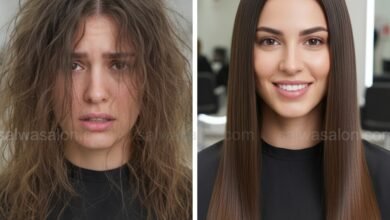Unlocking Nature's Secrets: A Scientific Guide to Stimulate Hair Growth

Experiencing continuous hair loss can be a frustrating experience. Constantly switching shampoo products without seeing results, coupled with bombastic claims from various hair treatments, often only adds to the confusion. At Salwa Salon, we understand that effective solutions are rooted in deep understanding, not just trial and error. As beauty educators, our mission is to empower you with science-based knowledge to take control of your hair health.
This article is not just a list of ordinary home remedies. It is an in-depth guide that will dissect the ‘why’ and ‘how’ some natural ingredients that might already be in your kitchen can scientifically work to stimulate follicles and support a healthy hair growth cycle. Let’s leave myths behind and focus on facts.
Understanding Hair Physiology: The Key to Overcoming Hair Loss
Before discussing solutions, it is crucial to understand the scientific fundamentals behind hair growth. Every strand of hair on your head goes through a complex three-phase cycle. Disturbances in any of these phases can lead to significant thinning and hair loss.
- Anagen Phase (Growth): This is the active phase where cells in the hair root divide rapidly, causing hair to grow approximately 1 cm every 28 days. This phase can last 2 to 6 years.
- Catagen Phase (Transition): A brief transitional phase lasting about 2-3 weeks. Hair growth stops, and the outer root sheath shrinks and attaches to the hair root.
- Telogen Phase (Rest): This is a resting phase lasting about 100 days. Hair in this phase will fall out when you comb or wash it, making way for new anagen hair.
Excessive hair loss (Telogen Effluvium) occurs when the percentage of hair entering the telogen phase drastically increases. This can be triggered by various factors, ranging from nutritional deficiencies (such as B vitamins and iron), physiological stress, hormonal changes, to scalp inflammation. Our approach is to target the root of these problems by nourishing the scalp and stimulating follicles to return to a healthy anagen phase.
4 Science-Based Natural Ingredients for Hair Follicle Stimulation
Here are four ingredients that have been studied and shown significant potential in supporting hair growth. We will outline their mechanisms of action, supporting scientific evidence, and proper application methods for optimal results.
1. Onion Juice: The Power of Sulfur for Follicle Regeneration
Onion is not just a kitchen spice. Topically, its juice is a rich source of dietary sulfur. Sulfur is a fundamental component of keratin, the main structural protein that forms hair. Adequate sulfur intake is crucial for hair strength and elasticity.
Scientific Mechanism: The high sulfur content in onion juice helps boost collagen production, which in turn supports healthy skin cell growth and hair follicle regeneration. Furthermore, a study published in the Journal of Dermatology found that applying onion juice twice daily for six weeks significantly promoted hair regrowth in participants with Alopecia Areata (patchy baldness). Researchers attributed these results to its sulfur content and the antioxidant properties of its flavonoids.
Proper Application Method:
- Blend 1-2 onions and strain to extract the juice.
- Use a cotton ball to apply the juice evenly over the entire scalp, focusing on thinning areas.
- Massage gently for 2-3 minutes to improve circulation.
- Leave on for 30-60 minutes. The aroma is strong, so ensure good room ventilation.
- Rinse thoroughly with a mild shampoo to remove the smell. Do this 2-3 times a week.
2. Castor Oil: Ricinoleic Acid for Microcirculation
Castor oil, especially cold-pressed varieties, is a very popular natural ingredient in hair care. Its effectiveness lies not in its vitamins or minerals, but in its unique fatty acid composition.
Scientific Mechanism: Castor oil contains approximately 90% ricinoleic acid, a type of omega-9 fatty acid. Research shows that ricinoleic acid is a potent inhibitor of Prostaglandin D2 (PGD2). High levels of PGD2 are found on the scalps of men with male pattern baldness (androgenetic alopecia) and are known to inhibit hair growth. By applying it topically, castor oil can help improve microcirculation in the scalp, ensuring follicles receive sufficient nutrients and oxygen to remain in the anagen phase.
Proper Application Method:
- Castor oil has a very thick viscosity. Mix it with a lighter carrier oil such as coconut or jojoba oil in a 1:1 ratio.
- Slightly warm the oil mixture for better absorption.
- Apply directly to the scalp and massage with fingertips for 5-10 minutes.
- Wrap your head with a warm towel and leave it on for at least 1 hour or overnight.
- Wash hair thoroughly (may require two shampoos). Do this 1-2 times a week.
3. Rosemary Essential Oil: A Natural Alternative Comparable to Minoxidil
Rosemary essential oil is more than just aromatherapy. Its efficacy in stimulating hair growth has been directly compared to standard pharmaceutical treatments.
Scientific Mechanism: A landmark clinical study in 2015 compared the effectiveness of rosemary oil with Minoxidil 2%, a common treatment for androgenetic alopecia. After six months, the group using rosemary oil experienced a significant increase in hair count, comparable to the Minoxidil group, but with fewer instances of scalp itching side effects. Its mechanism is believed to be due to its ability to improve blood circulation to the follicles, act as a powerful antioxidant, and block DHT (dihydrotestosterone) from attaching to follicle receptors.
Proper Application Method:
- Essential oils are very concentrated and SHOULD NOT be used directly.
- Mix 5-10 drops of pure rosemary essential oil with 2 tablespoons of a carrier oil (jojoba, almond, or coconut).
- Apply to the scalp, massage, and leave on for at least 30 minutes before shampooing.
- Another alternative: add 2-3 drops to your shampoo portion when washing your hair.
4. Green Tea: The Antioxidant Power of EGCG to Protect Follicles
The antioxidant-rich brew of green tea is not only beneficial for the body when consumed but also holds great potential when applied topically to the scalp.
Scientific Mechanism: Green tea is rich in polyphenol compounds called catechins, with the most abundant and potent being epigallocatechin gallate (EGCG). EGCG has been scientifically proven to protect dermal papilla cells (key cells in hair follicles) from oxidative stress-induced cell death. Furthermore, EGCG can help prolong the anagen phase and stimulate hair follicles to promote growth.
Proper Application Method:
- Brew 2 green tea bags in one cup of hot water and let it cool completely.
- After shampooing and conditioning, use the green tea brew as a final rinse.
- Pour slowly onto the scalp while gently massaging.
- Do not rinse further. Dry and style your hair as usual. Do this 2-3 times a week.
When Should You Consult a Professional?
While these natural ingredients offer a promising approach, it’s important to have realistic expectations and know when to seek medical help. Natural treatments require consistency and patience, with results potentially appearing after 3-6 months of regular use. However, if you experience severe, sudden hair loss, or it’s accompanied by other symptoms such as inflammation or scalp pain, it is highly recommended to consult a dermatologist or trichologist. Underlying medical conditions may require professional diagnosis and treatment.
Conclusion: A Holistic Approach to Healthy Hair
Addressing hair loss is not about finding one “miracle product,” but rather understanding the science behind it and implementing informed solutions. By harnessing the power of sulfur from onions, ricinoleic acid from castor oil, the stimulating properties of rosemary, and the antioxidants from green tea, you can create a robust, evidence-based hair care routine from the comfort of your home. Remember that hair health is a reflection of internal health. Combine these topical treatments with a balanced diet, stress management, and adequate hydration for holistic and sustainable results. At SalwaSalon.com, we believe that education is the first step towards true beauty.






